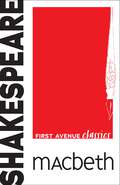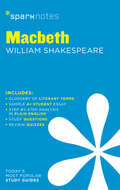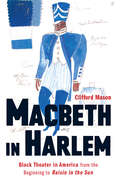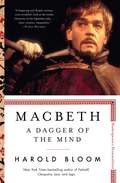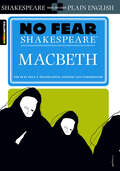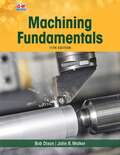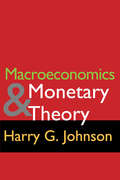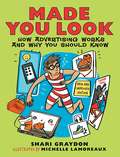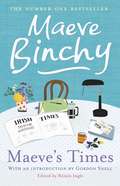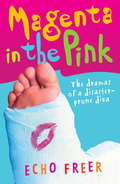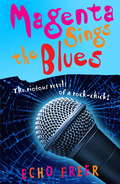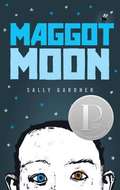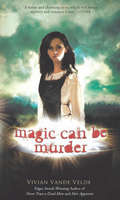- Table View
- List View
Macbeth (A Pacemaker Classic)
by William ShakespeareThis series inspires reading success and further exploration for all students. These classics are skillfully adapted into concise, softcover books.
Macbeth (First Avenue Classics ™)
by William ShakespeareTwo Scottish generals, Macbeth and Banquo, are on their way home from successful battles when they encounter three witches. With the prophecies of power and fame they give him swirling through his head, Macbeth tells his wife that the witches divined that he would become king of Scotland. Eager to see her husband as king, Lady Macbeth encourages him to murder King Duncan and assume the throne. A tale of obsession and forcing the fates, this unabridged version of William Shakespeare's classic English tragedy was first published in 1623.
Macbeth SparkNotes Literature Guide (SparkNotes Literature Guide Series #43)
by SparkNotesMacbeth SparkNotes Literature Guide by William Shakespeare Making the reading experience fun! When a paper is due, and dreaded exams loom, here's the lit-crit help students need to succeed! SparkNotes Literature Guides make studying smarter, better, and faster. They provide chapter-by-chapter analysis; explanations of key themes, motifs, and symbols; a review quiz; and essay topics. Lively and accessible, SparkNotes is perfect for late-night studying and paper writing. Includes:An A+ Essay—an actual literary essay written about the Spark-ed book—to show students how a paper should be written.16 pages devoted to writing a literary essay including: a glossary of literary termsStep-by-step tutoring on how to write a literary essayA feature on how not to plagiarize
Macbeth in Harlem: Black Theater in America from the Beginning to Raisin in the Sun
by Clifford MasonIn 1936 Orson Welles directed a celebrated all-black production of Macbeth that was hailed as a breakthrough for African Americans in the theater. For over a century, black performers had fought for the right to perform on the American stage, going all the way back to an 1820s Shakespearean troupe that performed Richard III, Othello, and Macbeth, without relying on white patronage. "Macbeth" in Harlem tells the story of these actors and their fellow black theatrical artists, from the early nineteenth century to the dawn of the civil rights era. For the first time we see how African American performers fought to carve out a space for authentic black voices onstage, at a time when blockbuster plays like Uncle Tom’s Cabin and The Octoroon trafficked in cheap stereotypes. Though the Harlem Renaissance brought an influx of talented black writers and directors to the forefront of the American stage, they still struggled to gain recognition from an indifferent critical press. Above all, "Macbeth" in Harlem is a testament to black artistry thriving in the face of adversity. It chronicles how even as the endemic racism in American society and its theatrical establishment forced black performers to abase themselves for white audiences’ amusement, African Americans overcame those obstacles to enrich the nation’s theater in countless ways.
Macbeth: A Dagger of the Mind (Shakespeare's Personalities #5)
by Harold BloomFrom the greatest Shakespeare scholar of our time, comes a portrait of Macbeth, one of William Shakespeare’s most complex and compelling anti-heroes—the final volume in a series of five short books about the great playwright’s most significant personalities: Falstaff, Cleopatra, Lear, Iago, Macbeth.From the ambitious and mad titular character to his devilish wife Lady Macbeth to the moral and noble Banquo to the mysterious Three Witches, Macbeth is one of William Shakespeare’s more brilliantly populated plays and remains among the most widely read, performed in innovative productions set in a vast array of times and locations, from Nazi Germany to Revolutionary Cuba. Macbeth is a distinguished warrior hero, who over the course of the play, transforms into a brutal, murderous villain and pays an extraordinary price for committing an evil act. A man consumed with ambition and self-doubt, Macbeth is one of Shakespeare’s most vital meditations on the dangerous corners of the human imagination. Award-winning writer and beloved professor Harold Bloom investigates Macbeth’s interiority and unthinkable actions with razor-sharp insight, agility, and compassion. He also explores his own personal relationship to the character: Just as we encounter one Anna Karenina or Jay Gatsby when we are seventeen and another when we are forty, Bloom writes about his shifting understanding—over the course of his own lifetime—of this endlessly compelling figure, so that the book also becomes an extraordinarily moving argument for literature as a path to and a measure of our humanity. Bloom is mesmerizing in the classroom, wrestling with the often tragic choices Shakespeare’s characters make. He delivers that kind of exhilarating intimacy and clarity in Macbeth, the final book in an essential series.
Macbeth: No Fear Shakespeare Side-by-Side Plain English (No Fear Shakespeare)
by William Shakespeare SparkNotesThis No Fear Shakespeare ebook gives you the complete text of Macbeth and an easy-to-understand translation.Each No Fear Shakespeare containsThe complete text of the original playA line-by-line translation that puts Shakespeare into everyday languageA complete list of characters with descriptionsPlenty of helpful commentary
Machine Trades Print Reading
by Michael A. Barsamian Richard A. GizelbachMachine Trades Print Reading is a combination text and write-in workbook designed to help students develop the skills required to visualize and interpret industrial prints. In addition to an overview of the role of prints in the design and manufacturing process, this text teaches students the fundamentals of visualizing shapes, line usage, title blocks and notes, math, measurement, dimensions, and tolerances. The new edition complies with the most recent ASME Y14.5 standard, resulting in a heavy revision of Unit 15—Geometric Dimensioning and Tolerancing. Print reading activities and unit review questions are included at the end of most units to provide you with valuable hands-on learning opportunities.
Machine Trades Print Reading, Fifth Edition
by Michael A. Barsamian Richard A. GizelbachMachine Trades Print Reading allows you to develop the basic skills required for visualizing and interpreting industrial prints. The text consists of 13 units. The first four units give you the basics of print reading. Units 5 through 12 deal with industrial prints. Unit 13 is a collection of prints with quiz questions that review all of the material presented in the text.
Machines That Become Us: The Social Context of Personal Communication Technology
by James E. KatzSocial critics and artificial intelligence experts have long prophesized that computers and robots would soon relegate humans to the dustbin of history. Many among the general population seem to have shared this fear of a dehumanized future. But how are people in the twenty-first century actually reacting to the ever-expanding array of gadgets and networks at their disposal? Is computer anxiety a significant problem, paralyzing and terrorizing millions, or are ever-proliferating numbers of gadgets being enthusiastically embraced? Machines that Become Us explores the increasingly intimate relationship between people and their personal communication technologies.In the first book of its kind, internationally recognized scholars from the United States and Europe explore this topic. Among the technologies analyzed include the Internet, personal digital assistants (PDAs), mobile phones, networked homes, smart fabrics and wearable computers, interactive location badges, and implanted monitoring devices. The authors discuss critical policy issues, such as the problems of information resource access and equity, and the recently discovered digital dropouts phenomena.The use of the word become in the book's title has three different meanings. The first suggests how people use these technologies to broaden their abilities to communicate and to represent themselves to others. Thus the technologies become extensions and representatives of the communicators. A second sense of become applies to analysis of the way these technologies become physically integrated with the user's clothing and even their bodies. Finally, contributors examine fashion aspects and uses of these technologies, that is, how they are used in ways becoming to the wearer. The conclusions of many chapters are supported by data, including ethnographic observations, attitude surveys and case studies from the United States, Britain, France, Italy, Finland, and Norway. This approach is especially valuable
Machining Fundamentals
by Bob Dixon John WalkerMachining Fundamentalsis a comprehensive text that provides an introduction to the various machining operations, setups, and procedures. This colorful and detailed textbook covers all traditional machining methods, as well as newer and nontraditional methods. This edition includes expanded coverage of geometric dimensioning and tolerancing; additional features on careers, workplace skills, and green machining practices; and updated illustrations. Clear, easy-to-understand introduction to machining. Strong emphasis on safety throughout the textbook. Career Connections, Workplace Skills, and Green Machining features engage, motivate, and prepare students for career success. Heavily illustrated with well-designed, color-coded artwork to help students understand concepts quickly. Correlated to the duties and standards for NIMS Machining Level I to help students achieve certification.
Machining Fundamentals
by Bob Dixon John R. WalkerMachining Fundamentals is a comprehensive text that offers a clear, easy-to-understand introduction to the various machining operations, setups, and procedures, providing an outstanding value for introductory courses. With a strong emphasis on safety, this colorful and detailed textbook covers all traditional machining methods, as well as newer and nontraditional methods. This edition aligns to the NIMS Machining Smart Standards and includes updated coverage of geometric dimensioning and tolerancing to reflect the ASME Y14.5-2018 standard. It features updated illustrations, new end-of-chapter review questions, and enhanced lesson plans.
Macroeconomics (Advanced Placement Economics, Fourth Edition)
by Margaret A. RayLearn more about economic forces in this advanced placement textbook.
Macroeconomics and Monetary Theory
by Harry G. JohnsonMacroeconomics is an outgrowth from the main stream of classical monetary theory following Keynes. Keynes changed the emphasis from determination of the level of money prices to determination of the level of output and employment. He also changed the key relationship from demand and supply of money as determining the price level to the relationship between consumption expenditure and income, in conjunction with private investment expenditure, as determining the level of output and therefore employment demanded. The income multiplier replaced the velocity of circulation as the key concept of monetary theory. The tendency of the past twenty-five years has been to reintegrate Keynesian and classical monetary theory into one general system of analysis. Moreover, as inflation has succeeded mass unemployment as a major policy problem, interest in classical monetary theory has revived, while Keynesians have increasingly' emphasized the monetary aspects of Keynesian theory. The proper contemporary distinction is not between two separate branches of economic theory, but between two areas of application or contexts of the theory of rational maximizing behavior. In the one (the microeconomic) context, it is assumed either that the overall workings of the economic system can be disregarded, or that the macroeconomic relationships are in full general equilibrium. In the other (the macroeconomic) context, it is assumed that the maximizing decisions of individual economic units (firms and households) will not necessarily add up to a macroeconomic equilibrium, but will produce a disequilibrium situation that will in the course of time produce changes in the individual decisions.
Madame Bovary (First Avenue Classics ™)
by Gustave FlaubertEmma dreams of sophistication, wealth, and romance, but what she gets is a marriage to Charles Bovary, a provincial, middle-class doctor who is a devoted but boring husband. She tries her hardest to be a loyal and loving wife, even as she grows to resent him more and more for his insufferable dullness. Soon, though, she is seduced by the dashing Rodolphe and gives into her desires. In their affair, Emma believes she has finally found true, passionate love. She borrows money to lavish Rodolphe with expensive gifts, and the neighbors begin to gossip about her indiscretion. When the moneylender comes to collect and Rodolphe leaves her, where will Emma turn? This tragic romance by Gustave Flaubert was first published in French in 1857. This is an unabridged version taken from the 1886 translation by Eleanor Marx-Aveling.
Maddie Finn
by Garry DisherMaddie Finn lives with her mother above a converted stable in the grounds of a big house owned by the gloomy Harold Delamore. It's their `cosy refuge against the world? and Maddie's favourite task is to walk Sal, Mr Delamore's rare, prize-winning dog. But one day Maddie and her mother are given two months notice by the trouble-making Delia Delamore, home from her boarding school ? or has she been expelled?And when Maddie takes Sal for a walk the next morning, Delia comes too...into a dark alley, where a gang of kidnappers is waiting...But who do they want?Maddie Finn is a tense, exciting story of a difficult friendship by Garry Disher, bestselling author of The Divine Wind and The Bamboo Flute.
Made You Look: How Advertising Works and Why You Should Know
by Shari GraydonIntended to educate children about advertising-talks about the history of advertising from ancient Greece, through the Industrial Revolution, down to digital advertising today.
Made in Asian America: A History for Young People
by Erika Lee Christina SoontornvatFrom three-time Newbery Honoree Christina Soontornvat and award-winning historian Erika Lee comes a middle grade nonfiction that shines a light on the generations of Asian Americans who have transformed the United States and who continue to shape what it means to be American.Asian American history is not made up of one single story. It’s many. And it’s a story that too often goes untold. It begins centuries before America even exists as a nation. It is connected to the histories of Western conquest and colonialism. It’s a story of migration; of people and families crossing the Pacific Ocean in search of escape, opportunity, and new beginnings.It is also the story of race and racism. Of being labeled an immigrant invasion, unfit to become citizens, and being banned, deported, and incarcerated. Of being blamed for bringing diseases into the country.It is also a story of bravery and hope. It is the story of heroes who fought for equality in the courts, on the streets, and in the schools, and who continue to fight in solidarity with others doing the same.This book is a stirring account of the ordinary people and extraordinary acts that made Asian America and the young people who are remaking America today.
Maeve's Times
by Maeve Binchy'Maeve's Times is funny and clever and kind, which are excellent qualities in both books and people' Irish Times'As someone who fell off a chair not long ago trying to hear what they were saying at the next table in a restaurant, I suppose I am obsessively interested in what some might consider the trivia of other people's lives.'Maeve Binchy is well known for her bestselling novels, but for many years Maeve was a journalist. From 'The Student Train' to 'Plane Bores' and 'Bathroom Joggers' to 'When Beckett met Binchy', these articles have all the warmth, wit and humanity of her fiction. Arranged in decades, from the 1960s to the 2000s, and including Maeve's first and last ever piece of writing for the Irish Times, the columns also give a fascinating insight into the author herself.With an introduction written by her husband, the writer Gordon Snell, this collection of timeless writing reminds us of why the leading Irish writer was so universally loved.
Mafia Girl
by Deborah Blumenthal"What's in a name? Everything . . . if you have my name." At her exclusive Manhattan high school, seventeen-year-old Gia is the most hated/loved girl in school. Why? Her father doesn't have a boss. He is the boss--the capo di tutti cappi, boss of all bosses. Not that Gia cares. But life gets complicated when she meets a cop she calls "Officer Hottie" and feels a surprising chemistry. Then Vogue magazine wants to feature Gia in a fashion spread about real-life bad girls. On top of this, she's running for class president. Can Gia step out from under her dad's shadow and show everyone there's more to her than "Mafia Girl?"
Magenta Goes Green
by Echo FreerMagenta's in trouble with Daniel again - this time, for snogging the school new-boy Chad Albright on a charity Blind Date. As if this wasn't bad enough, she's been picked to go on the school outward-bound camp. It's not really her cup of tea - mix Magenta with any physical activities, and here comes disaster ...
Magenta Orange
by Echo FreerCalamity seems to follow Magenta everywhere. Her neighbour, Daniel, tries to help but, inevitably, ends up inveigled into her schemes with hilarious results. Magenta has set her sights on Year 11 heart-throb, Adam Jordan, but all her attempts to impress him are thwarted by a series of mishaps. Adam is convinced she is a jinx and tries to avoid her at all costs - while Daniel spends his time trying to demonstrate his undying affection for Magenta - will the best man win?
Magenta Orange: Magenta in the Pink
by Echo FreerMagenta has finally got it together with her neighbour - and nearest thing to a best friend a boy can be - Daniel. But nothing is ever easy for Magenta - as she prepares to take the starring role in the school play, will the course of true love never run smooth?
Magenta Sings The Blues
by Echo FreerMagenta's best friends are going to be performing in the Battle of the Bands - but they haven't asked her to join! OK, so she's tone deaf, but that shouldn't be a barrier for the truly talented. And Magenta needs to be centre stage to catch the attention of this year's hottest talent, Spyros Evangelides. If only she didn't have two left feet, she could become a disco diva and show ex-boyfriend Daniel what he's missing ...
Maggot Moon
by Sally Gardner Julian CrouchWhat if the football hadn't gone over the wall. On the other side of the wall there is a dark secret. And the devil. And the Moon Man. And the Motherland doesn't want anyone to know. But Standish Treadwell -- who has different-colored eyes, who can't read, can't write, Standish Treadwell isn't bright -- sees things differently than the rest of the "train-track thinkers." So when Standish and his only friend and neighbor, Hector, make their way to the other side of the wall, they see what the Motherland has been hiding. And it's big...One hundred very short chapters, told in an utterly original first-person voice, propel readers through a narrative that is by turns gripping and darkly humorous, bleak and chilling, tender and transporting.
Magic Can Be Murder
by Vivian Vande Velde&“[A] lighthearted mystery . . . Kids who like mystery and fantasy and fans of television&’s Sabrina, about a teenage witch, will like this&” (Booklist). Nola&’s not much of a witch—she can work only a few useless spells, like the one that lets her spy on people. But there&’s no spell for keeping her crazy mother—who hears voices and is a magnet for witch-hunters—out of trouble. The two flee from town to town until the day Nola witnesses a murder. Which is bad enough, but worse is that the murderer may frame Nola and her mother for the crime. And then no amount of magic will save her. And you think your teenage years are tough . . . &“Dialogue is fast and funny, the characters evincing a certain human desperation that makes them (the good guys, anyway) unfailingly sympathetic. Introduce Rowling fans to Vande Velde, and watch them make magic.&” —The Bulletin of the Center for Children&’s Books &“Vande Velde has produced a winner in this fantasy mystery . . . [Fans] will not be disappointed in this funny and charming story, which will attract mystery and romance lovers as well.&” —VOYA &“Vande Velde&’s offering throws murder, witchcraft, and romance into the brew . . . The well-developed characters provide entertaining reading.&” —School Library Journal &“Fun and suspense for readers . . . Entertaining.&” —Publishers Weekly &“The story moves from a witch&’s tale of many spells, to a murder mystery, and finally, a love story . . . Amusing, light reading.&” —Kliatt &“An entertaining fantasy for any reader.&” —SF Site

